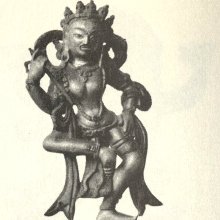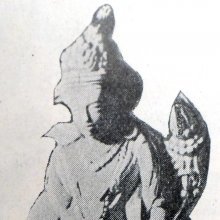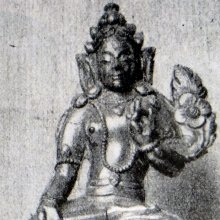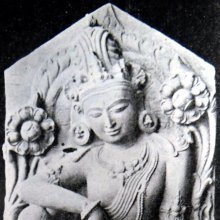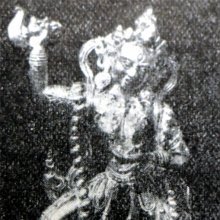Vajrankushi, Vajrāṅkuśī, Vajra-ankusi: 6 definitions
Introduction:
Vajrankushi means something in Buddhism, Pali, Hinduism, Sanskrit. If you want to know the exact meaning, history, etymology or English translation of this term then check out the descriptions on this page. Add your comment or reference to a book if you want to contribute to this summary article.
The Sanskrit term Vajrāṅkuśī can be transliterated into English as Vajrankusi or Vajrankushi, using the IAST transliteration scheme (?).
Images (photo gallery)
(+5 more images available)
In Buddhism
Tibetan Buddhism (Vajrayana or tantric Buddhism)
Source: Wisdom Library: Tibetan BuddhismVajrāṅkuśī (वज्राङ्कुशी) is the name of Dūtī (i.e., messengers of Lord Vajrapāṇi) mentioned as attending the teachings in the 6th century Mañjuśrīmūlakalpa: one of the largest Kriyā Tantras devoted to Mañjuśrī (the Bodhisattva of wisdom) representing an encyclopedia of knowledge primarily concerned with ritualistic elements in Buddhism. The teachings in this text originate from Mañjuśrī and were taught to and by Buddha Śākyamuni in the presence of a large audience (including Vajrāṅkuśī).
Source: archive.org: The Indian Buddhist Iconography1) Vajrāṅkuśī (वज्राङ्कुशी) refers to one of the ten Goddesses of the Vajratārāmaṇḍala belonging to Vajratārā: one of the various emanations of Ratnasambhava, as mentioned in the 5th-century Sādhanamālā (a collection of sādhana texts that contain detailed instructions for rituals).—Accordingly, the sādhana further says that the Guardians of the Gates should also be meditated upon as around the principal Goddess, but apparently not in the same circle with the [four cardinal Goddess]:—“On the eastern gate there is Vajrāṅkuśī who is one-faced and two-armed. She carries in her two hands the goad marked with a vajra and the night lotus. She has a distorted face and is blue in colour”.
All these Goddesses [viz., Vajrāṅkuśī ] stand on the orb of the sun in the ālīḍha attitude with the right leg stretched forward. They are radiant like the Sun-god and are surrounded with a fiery halo. They are decked in ornaments of snakes. [...] These Goddesses originate from the ten different letters of the mantra of Vajratārā, which is “oṃ tāre tuttāre ture svāhā”, consisting of ten syllables. Each syllable brings forth a Goddess, and these Goddesses are said to be the embodiments of the ten paramitas of the Mahāyāna School.
2) Vajrāṅkuśī (वज्राङ्कुशी) presides over the East and represents one of the six Goddesses of the directions, commonly depicted in Buddhist Iconography, and mentioned in the 11th-century Niṣpannayogāvalī of Mahāpaṇḍita Abhayākara.—Her Colour is white; her Symbol is the goad; she has one face and two arms.—The first goddess in the series is Vajrāṅkuśī who is the presiding deity of the Eastern direction.
Vajrapāśī is described in Niṣpannayogāvalī (vajratārāmaṇḍala) and Sādhanamālā (vajratārāsādhana) as follows:—
“On the Eastern gate is Vajrāṅkuśī white in colour holding in her right hand the white Goad.”
[The left hand shows like the rest the raised index firmer.]

Tibetan Buddhism includes schools such as Nyingma, Kadampa, Kagyu and Gelug. Their primary canon of literature is divided in two broad categories: The Kangyur, which consists of Buddha’s words, and the Tengyur, which includes commentaries from various sources. Esotericism and tantra techniques (vajrayāna) are collected indepently.
Languages of India and abroad
Sanskrit dictionary
Source: Cologne Digital Sanskrit Dictionaries: Edgerton Buddhist Hybrid Sanskrit DictionaryVajrāṅkuśī (वज्राङ्कुशी).—name of a goddess: Mahāvyutpatti 4284; Sādhanamālā 50.3 etc.
Source: Cologne Digital Sanskrit Dictionaries: Monier-Williams Sanskrit-English DictionaryVajrāṅkuśī (वज्राङ्कुशी):—[from vajrāṅkuśa > vajra > vaj] f. Name of a goddess, [Buddhist literature]
Source: DDSA: Paia-sadda-mahannavo; a comprehensive Prakrit Hindi dictionary (S)Vajrāṅkuśī (वज्राङ्कुशी) in the Sanskrit language is related to the Prakrit word: Vajjaṃkusī.
[Sanskrit to German]
Sanskrit, also spelled संस्कृतम् (saṃskṛtam), is an ancient language of India commonly seen as the grandmother of the Indo-European language family (even English!). Closely allied with Prakrit and Pali, Sanskrit is more exhaustive in both grammar and terms and has the most extensive collection of literature in the world, greatly surpassing its sister-languages Greek and Latin.
See also (Relevant definitions)
Partial matches: Vajra, Ankushi.
Full-text: Vajjamkusi, Hayasya, Vajrataramandala, Lokanatha.
Relevant text
Search found 2 books and stories containing Vajrankushi, Vajrāṅkuśī, Vajra-ankusi, Vajrankusi, Vajra-aṅkuśī; (plurals include: Vajrankushis, Vajrāṅkuśīs, ankusis, Vajrankusis, aṅkuśīs). You can also click to the full overview containing English textual excerpts. Below are direct links for the most relevant articles:
